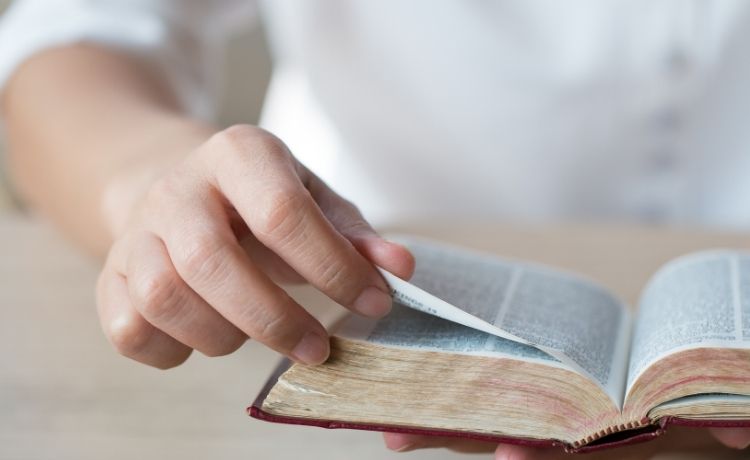As Christmas comes around this year, things are a bit different. Having our usual gatherings is more difficult, if not impossible. Flying the family down to Florida or flying back home to visit may not be an option. And even as we’re supposed to be in high spirits for the season, it’s difficult not to reflect on the challenges and losses we’ve collectively experienced this year.
Since this year is already so different, perhaps you can finish it by taking a different, more reflective approach to Christmas. Try to remember the “reason for the season” by acquainting—or reacquainting—yourself with the Bible in the run-up to the holidays. But merely reading the Bible is not the same as studying the Bible. Don’t just skim the pages and breeze through the begats. Try to get the most out of reading so that you can apply its lessons to your life.
There are so many different techniques to study the Bible to choose from. Here are a few of our favorites—some easier, some harder, but all of them spiritually nourishing.
Sword Method
The sword method uses the image of a sword held in the hand and pointed toward the sky to represent Bible study. The sword, which draws a line between a person and the heavens, diagrams six key questions along its edges, its point, and the hand that grasps the sword. The questions ask you to examine sin, promise, example, and command as well as ask what each chapter teaches about God and people.
Inductive Method
Approaching each chapter with such a long list of questions may appear daunting. Maybe every question isn’t readily applicable to every reading. The inductive method of Bible study asks the reader to observe, interpret, and apply selected passages. This entails closely understanding key components of storytelling such as characters, setting, and conflict. From there, ask the question you remember asking in high school math: “How do I use this in real life?” With any luck, the answer will be clearer than it was in calculus.
SOAP Method
Not to worry: the SOAP method has nothing to do with washing your mouth out with soap. Rather, SOAP is an acronym for scripture, observation, application, prayer. The SOAP method is similar to the inductive method, but with the addition of a closing prayer to finalize each study session. Writing key verses as you read can help you observe and apply passages as well.
Journaling
Some of these study methods can feel an awful lot like homework, and maybe you feel that your homework days are done. Perhaps a more freeform approach to Bible study is right for you. Simply take notes on the Bible as you read and keep a journal of your thoughts, observations, and feelings as you read. Work through questions you have about the text and about yourself, and feel free to creatively and actively engage with what you read. Journaling can even take the form of art.
Whether you make it a Christmas gift to yourself or a New Year’s resolution, choose one of these different techniques to study the Bible and embark upon a program of spiritual growth in these challenging times.










 Deering Estate
Deering Estate
 Massage Envy South Miami
Massage Envy South Miami
 Calla Blow Dry
Calla Blow Dry
 My Derma Clinic
My Derma Clinic
 Sushi Maki
Sushi Maki
 Sports Grill
Sports Grill
 The Healthy Kitchen
The Healthy Kitchen
 Golden Rule Seafood
Golden Rule Seafood
 Malanga Cuban Café
Malanga Cuban Café

 Kathleen Ballard
Kathleen Ballard
 Panter, Panter & Sampedro
Panter, Panter & Sampedro
 Vintage Liquors
Vintage Liquors
 The Dog from Ipanema
The Dog from Ipanema
 Rubinstein Family Chiropractic
Rubinstein Family Chiropractic
 Your Pet’s Best
Your Pet’s Best
 Indigo Republic
Indigo Republic




 ATR Luxury Homes
ATR Luxury Homes


 2112 Design Studio
2112 Design Studio
 Hamilton Fox & Company
Hamilton Fox & Company
 Creative Design Services
Creative Design Services
 Best Pest Professionals
Best Pest Professionals
 HD Tree Services
HD Tree Services
 Trinity Air Conditioning Company
Trinity Air Conditioning Company
 Cisca Construction & Development
Cisca Construction & Development
 Mosquito Joe
Mosquito Joe
 Cutler Bay Solar Solutions
Cutler Bay Solar Solutions


 Miami Royal Ballet & Dance
Miami Royal Ballet & Dance
 Christopher Columbus
Christopher Columbus
 Pineview Preschools
Pineview Preschools
 Westminster
Westminster
 Carrollton
Carrollton
 Lil’ Jungle
Lil’ Jungle
 Frost Science Museum
Frost Science Museum
 Palmer Trinity School
Palmer Trinity School
 South Florida Music
South Florida Music
 Pinecrest Orthodontics
Pinecrest Orthodontics
 Dr. Bob Pediatric Dentist
Dr. Bob Pediatric Dentist
 d.pediatrics
d.pediatrics
 South Miami Women’s Health
South Miami Women’s Health

 The Spot Barbershop
The Spot Barbershop
 My Derma Clinic
My Derma Clinic




 Miami Dance Project
Miami Dance Project

 Rubinstein Family Chiropractic
Rubinstein Family Chiropractic
 Indigo Republic
Indigo Republic

 Safes Universe
Safes Universe
 Vintage Liquors
Vintage Liquors
 Evenings Delight
Evenings Delight





 Atchana’s Homegrown Thai
Atchana’s Homegrown Thai
 Baptist Health South Florida
Baptist Health South Florida

 Laser Eye Center of Miami
Laser Eye Center of Miami
 Visiting Angels
Visiting Angels
 OpusCare of South Florida
OpusCare of South Florida

 Your Pet’s Best
Your Pet’s Best





 HD Tree Services
HD Tree Services
 Hamilton Fox & Company
Hamilton Fox & Company


 Creative Design Services
Creative Design Services